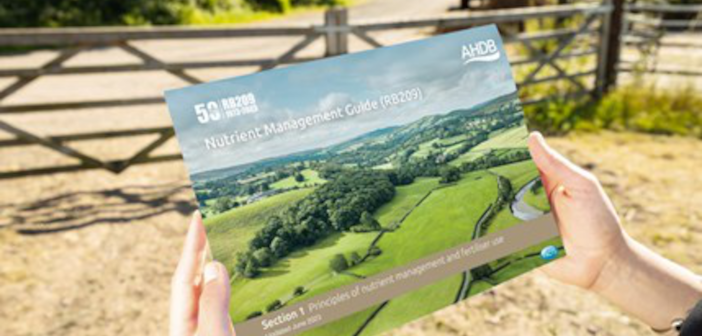The latest edition of the Nutrient Management Guide (RB209) has been released by AHDB, celebrating its 50th anniversary.
Published on the AHDB website, the edition features a number of improvements, including changes to the recommendations for cereals. AHDB will have hard copies of the guide available at events this year, including Cereals on June 13 and 14.
The document was first published in 1973 by the Ministry of Agriculture, Fisheries and Food (MAFF), RB209 (Reference Bulletin 209) was the first comprehensive set of fertiliser recommendations for major crops in the UK.
Following coordinated investment in nutrient management research, AHDB first published the guide in 2017, with revisions issued each year since.
The 2023 edition features updates to the first four sections of the guide:
- Principles of nutrient management and fertiliser use
- Organic materials
- Grass and forage crops
- Arable crops.
Dr Amanda Bennett, AHDB senior environment manager, said: “The 50-year edition includes notable changes to the recommendations for oats and key considerations for nitrogen management for milling wheat. For example, nitrogen rates for oats are now based on expected yield.
“We work in close partnership with many external parties and farmers, who participate in the UK Partnership for Crop Nutrient Management Steering Group and three sector Technical Working Groups. Collectively, these groups inform, coordinate, and collate the data. Critically, they ensure that updates are evidence-based and independently reviewed.”
Alli Grundy, an independent adviser and chair of the arable Technical Working Group, works with approximately 25 experts to examine data from across the sector to improve the guide. She said: “This backing means growers can be assured that the information is scientifically robust, providing the evidence needed to support decision making on the farm.
“I use RB209 daily. It’s an invaluable resource that acts as a baseline for building recommendations, bearing in mind influencing factors for the individual farm, such as conditions, soil type and farming system.”
James Price, director of Perdiswell Farm and chair of the Steering Group, uses RB209 to support buying decisions and nutrient management planning. He said: “Both my farm manager and I are FACTS qualified, so we work in partnership to plan nutrient applications in line with crop cycles. Without RB209 as an unbiased baseline, we’d be without a starting point.
“It’s the baseline for everything we do in terms of crop nutrition, after that we can make decisions above and beyond the information using our own experience.”
Have your say on Recommended Lists
At the Cereals Event (stand 138) and Groundswell, AHDB will ask growers for input on its Recommended Lists (RL) review. There will be an opportunity to provide feedback on the RL and vote on alternative table formats for the lists.
To download RB209 and for details about the latest changes, visit: ahdb.org.uk/rb209




